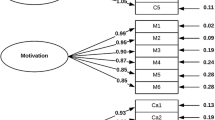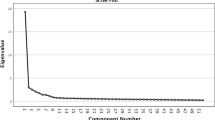Abstract
Self-determination theory proposes that autonomy support in the classroom is critical for students’ optimal motivation and performance. However, the literature has not adequately demonstrated the psychometric qualities of the most popular measurement for autonomy-supportive classrooms, the Learning Climate Questionnaire (LCQ) and its short version. Using the graded response model in item response theory (IRT), the current study evaluates the short version of the LCQ with a large sample (N = 13570). IRT and classic psychometric analyses show that the scale is generally satisfactory in measuring latent learning climate, with the exceptions that Item 4 appears to be inadequate and that the scale is relatively weak in distinguishing highly autonomy-supportive classrooms. We provide suggestions for future studies, such as dropping Item 4 and including more items that tap into instructional practices located on the higher end of the latent autonomy support spectrum. Implications of the current findings for the conceptualization of autonomy support are also discussed.



Similar content being viewed by others
Notes
Over-aged students constitute only a small proportion of this sample and did not have any substantial impact on the results. We reran the analysis with only those aged between 18 and 22, and the results were essentially the same. The RMSEA was the same, the difference in parameter estimates (αs & δs) were within 0.06, and the category response curves and information curves had the same shapes.
We also performed an exploratory factor analysis on the main dataset, which yielded very similar results to those of the smaller extra dataset that supported the uni-dimensionality.
According to Baker (2001), values for the discrimination parameter α from 0.01 to 0.24 are very low, 0.25 to 0.64 are low, 0.65 to 1.34 are moderate, 1.35 to 1.69 are high, and more than 1.7 are very high.
It should be noted that the examination of separation is relatively subjective. No quantitative indicator is available for this purpose.
References
Assor, A., Kaplan, H., & Roth, G. (2002). Choice is good, but relevance is excellent: Autonomy-enhancing and suppressing teacher behaviours predicting students’ engagement in schoolwork. British Journal of Educational Psychology, 72(2), 261–278. https://doi.org/10.1348/000709902158883.
Baker, F. B. (2001). The basics of item response theory (2nd ed.). College Park, MD: University of Maryland, ERIC Clearinghouse on Assessment and Evaluation.
Belmont, M., Skinner, E., Wellborn, J., & Connell, J. (1988). Teacher as social context: A measure of student perceptions of teacher provision of involvement, structure, and autonomy support (No. 102). Tech. rep.
Bock, R. D., & Aitkin, M. (1981). Marginal maximum likelihood estimation of item parameters: Application of an EM algorithm. Psychometrika, 46, 443–458. https://doi.org/10.1007/bf02293801.
Cai, L., Du Toit, S. H. C., & Thissen, D. (2011). IRTPRO: Flexible, multidimensional, multiple categorical IRT modeling [Computer software]. Chicago, IL: Scientific Software International.
Chiesi, F., Galli, S., Primi, C., Borgi, I., P., & Bonacchi, A. (2013). The accuracy of the life orientation test–revised (LOT–R) in measuring dispositional optimism: Evidence from item response theory analyses. Journal of Personality Assessment, 95(5), 523–529.
Deci, E. L., Connell, J. P., & Ryan, R. M. (1989). Self-determination in a work organization. Journal of Applied Psychology, 74(4), 580–590. https://doi.org/10.1037//0021-9010.74.4.580.
Deci, E. L., & Ryan, R. M. (2000). The” what” and” why” of goal pursuits: Human needs and the self-determination of behavior. Psychological Inquiry, 11(4), 227–268. https://doi.org/10.1207/s15327965pli1104_01.
Deci, E. L., Schwartz, A. J., Sheinman, L., & Ryan, R. M. (1981). An instrument to assess adults’ orientations toward control versus autonomy with children: Reflections on intrinsic motivation and perceived competence. Journal of Educational Psychology, 73(5), 642.
Dodeen, H., & Al-Darmaki, F. (2016). The application of item response theory in developing and validating a shortened version of the Emirate Marital Satisfaction Scale. Psychological Assessment, 28(12), 1625.
Embretson, S. E., & Reise, S. P. (2000). Item response theory for psychologists. Mahwah, NJ: Lawrence Erlbaum Associates.
Guay, F., & Vallerand, R. J. (1996). Social context, student’s motivation, and academic achievement: Toward a process model. Social Psychology of Education, 1(3), 211–233. https://doi.org/10.1007/bf02339891.
Hair, J. F. J., Black, W. C., Babin, B. J., & Anderson, R. E. (2010). Multivariate data analysis (7th ed.). London: Prentice Hall.
Ilardi, B. C., Leone, D., Kasser, T., & Ryan, R. M. (1993). Employee and supervisor ratings of motivation: Main effects and discrepancies associated with job satisfaction and adjustment in a factory setting. Journal of Applied Social Psychology, 23(21), 1789–1805. https://doi.org/10.1111/j.1559-1816.1993.tb01066.x.
Jang, H., Kim, E. J., & Reeve, J. (2012). Longitudinal test of self-determination theory’s motivation mediation model in a naturally occurring classroom context. Journal of Educational Psychology, 104(4), 1175–1188. https://doi.org/10.1037/a0028089.
Katz, I., & Assor, A. (2007). When choice motivates and when it does not. Educational Psychology Review, 19(4), 429–442. https://doi.org/10.1007/s10648-006-9027-y.
Levesque-Bristol, C., Knapp, T. D., & Fisher, B. J. (2011). The effectiveness of service-learning: It’s not always what you think. Journal of Experiential Education, 33(3), 208–224. https://doi.org/10.1177/105382590113300302.
Li, C. H. (2016). The performance of ML, DWLS, and ULS estimation with robust corrections in structural equation models with ordinal variables. Psychological Methods, 21(3), 369.
Mallinckrodt, B., & Tekie, Y. T. (2015). Revision of the Working Alliance Inventory and development of a brief revised version guided by item response theory. Psychotherapy Research, 26(6), 694–718.
Muraki, E. (1990). Fitting a polytomous item response model to Likert-type data. Applied Psychological Measurement, 14(1), 59–71.
Muthén, B., & Kaplan, D. (1985). A comparison of some methodologies for the factor analysis of non-normal Likert variables. British Journal of Mathematical and Statistical Psychology, 38(2), 171–189.
Muthen, B., & Kaplan, D. (1992). A comparison of some methodologies for the factor analysis of non-normal Likert variables: A note on the size of the model. British Journal of Mathematical and Statistical Psychology, 45(1), 19–30.
Reeve, J., & Jang, H. (2006). What teachers say and do to support students’ autonomy during a learning activity. Journal of Educational Psychology, 98(1), 209–218. https://doi.org/10.1037/0022-0663.98.1.209.
Ryan, R. M., & Deci, E. L. (2017). Self-determination theory: Basic psychological needs in motivation, development, and wellness. New York: Guilford Publishing.
Ryan, R. M., & Grolnick, W. S. (1986). Origins and pawns in the classroom: Self-report and projective assessments of individual differences in children’s perceptions. Journal of Personality and Social Psychology, 50(3), 550–558. https://doi.org/10.1037//0022-3514.50.3.550.
Samejima, F. (1969). Estimation of latent ability using a response pattern of graded scores. Psychometrika Monograph Supplement. https://doi.org/10.1007/bf03372160.
Sheldon, K. M., & Krieger, L. S. (2007). Understanding the negative effects of legal education on law students: A longitudinal test of self-determination theory. Personality and Social Psychology Bulletin, 33(6), 883–897. https://doi.org/10.1177/0146167207301014.
Soenens, B., & Vansteenkiste, M. (2005). Antecedents and outcomes of self-determination in 3 life domains: The role of parents’ and teachers’ autonomy support. Journal of Youth and Adolescence, 34(6), 589–604. https://doi.org/10.1007/s10964-005-8948-y.
Williams, G. C. (1993). Internalization of biopsychosocial values by medical students (Order No. 9405895). Retrieved from ProQuest Dissertations & Theses Global. (304051524).
Williams, G. C., & Deci, E. L. (1996). Internalization of biopsychosocial values by medical students: A test of self-determination theory. Journal of Personality and Social Psychology, 70(4), 767–779. https://doi.org/10.1037//0022-3514.70.4.767.
Wirth, R. J., & Edwards, M. C. (2007). Item factor analysis: Current approaches and future directions. Psychological Methods, 12(1), 58.
Yu, S., Chen, B., Levesque-Bristol, C., & Vansteenkiste, M. (2016). Chinese education examined via the lens of self-determination. Educational Psychology Review. https://doi.org/10.1007/s10648-016-9395-x.
Author information
Authors and Affiliations
Corresponding author
Rights and permissions
About this article
Cite this article
Yu, S., Traynor, A. & Levesque-Bristol, C. Psychometric examination of the short version of the learning climate questionnaire using item response theory. Motiv Emot 42, 795–803 (2018). https://doi.org/10.1007/s11031-018-9704-4
Published:
Issue Date:
DOI: https://doi.org/10.1007/s11031-018-9704-4




